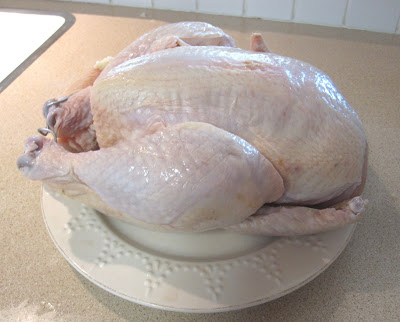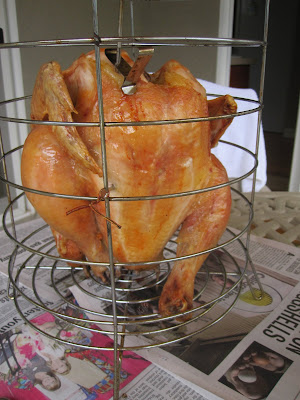I went to the store recently to buy a mixture of yams (red yams
and purple yams)
and sweet potatoes (whitish-skinned
and reddish skinned)
with the idea of cooking them and doing a post on the differences between yams and sweet potatoes, in general, and those types in particular. I picked up a cassava as well,
to see how it compared. What I have learned has turned everything I thought I knew about yams and sweet potatoes upside down. To me, yams were orange and very sweet. It is what I ate with some reluctance on Thanksgiving, often cooked in brown sugar and with apples or marshmallows. However, what I have always known as yams are actually sweet potatoes. What the rest of the world knows as yams, the true yams, are actually white-fleshed and bland. They are usually used as background food and hard to obtain in the U.S. In the U.S. the true yams are known as tropical yams. The tropical yams are not even related, botanically, to sweet potatoes. Yams are more closely related to lilies and grasses, their skins are more rough and scaly, or shaggy, and their flesh is more starchy and dry. There are over 600 varieties and the vast majority are grown in Africa. Sweet potatoes have thinner and more smooth skin, and their flesh is more moist and sweet. They originated in South America, are related to morning glories, and the very sweet orange types we call yams are only eaten in the U.S. (oh, the U.S. sweet tooth). There are two dominant types of sweet potatoes: (1) the harder, lighter, tan-skinned varieties with pale yellow or creamy flesh, and (2) the softer, darker red-skinned varieties with orange flesh. I have read that the softer varieties were called yams in the U.S. to distinguish them from the harder varieties and that the slave started calling some varieties yams because they reminded them of the yams they had in Africa.
The garnet yam and jewel yam, which are actually sweet potatoes, are the orange-fleshed sweet potatoes Americans think of as yams. They are rarely labeled clearly and they are very similar to each other. Both have orange moist flesh. The garnet yam is slender, ovate (egg-shaped) and cylindric (like a cylinder), tapers at the ends, and has a pale salmon color. The flesh is golden orange and turns a vibrant golden yellow when cooked. The jewel yam is also ovate, cylindric, and tapers at the ends.
It has been variously described as having a copper-colored skin, or a rose hued pale orange skin. The color of the jewel's brilliant orange colored flesh
actually increases when cooked. Both the garnet and jewel yams are sweet and starchy and absorb accompanying ingredient flavors. It appears that the major differences between them are that the garnet yam is more slender and the jewel yam's flesh is more orange than the garnet yam's flesh which is more yellow.
I believe that the yams (sweet potatoes) I got, which were labeled "red yams," were jewel yams.
I bought what was labeled as a "purple yam" which is actually an Okinawa purple potato or Okinawa yam.
It too is a sweet potato, native to the island of Okinawa, Japan. It is ovate, tubular and has tapered ends, and a buff colored skin with earthy spots. It has violet to purple flesh
and is very starchy. When cooked, the purple color intensifies.
I believe the sweet potatoes I bought with a tan colored outside
and cream-colored flesh may be the Nancy Hall variety.
The Kotobuki is also known as the Japanese yam, Japanese sweet potato and mountain yam. It is not a traditional U.S. sweet potato. It is roughly oblong, has a thin, rusted red colored skin
and a densely textured cream colored flesh.
It is not as moist as the "yam" sweet potatoes. One source says it has a nutty flavor, sort of like a roasted chestnut. Another source says the flesh is dry, starchy and subtly sweet.
It is native to China and Japan.
Cassava is native to South America and is grown for its starchy tuberous root.
It is the third largest source for carbohydrates in the world. It is also called mandioca or manioc in the U.S. and we saw it referred to as yuca in Peru, where we ate yuca fries, and confused it with yucca. The cassava root is long and tapered and encased in a rough, brown, detachable rind.
The flesh is white to yellowish.
Portuguese traders introduced cassava and maize to Africa in the 16th century and they have replaced native African crops as the most important staple foods. Cassava is known as the "bread of the tropics" and Nigeria is the world's largest producer. Cassava must be cooked properly to detoxify it as it contain cyanide.
When soft-boiled it can replace boiled potatoes and deep-fried it can replace fried potatoes. Tapioca is made from dried cassava root.
For my taste-testing, I boiled all of the tubers. In reading later, I found suggestions that sweet potatoes are best, baked, that boiling reduces some of the sweetness. Below, the boiled jewel yam (orange), Nancy Hall sweet potatoes (white) and purple yam (purple)
and Kotobuki (to the left) and cassava (to the right).
I mashed each with a fork and tried them with plain and with salt.
and
I then added butter and salt.
and
I found the orange-fleshed jewel yam (sweet potato) to be the lightest, easiest to mash and most sweet of all the varieties. I really loved the smooth texture and it would rank no.1 among the five varieties I ate. The Nancy Hall sweet potato was also very good - not quite as sweet as the jewel, but it would serve the same purpose and be nearly as good. The purple yams, or Okinawan purple potatoes, were much more dense than the jewel or Nancy Hall's. Where the other two floated in the boiling water, the purple yams sunk to the bottom. They were much more difficult to mash and not anywhere near as sweet. I did not really like them until I mixed them with butter. Once mixed with butter, I did enjoy the bites that were very buttery. I suspect they may be much better baked and if I got them again, that is how I would try and cook them. The Kotobuki was also much more dense and less sweet. I think I probably liked it even less than the purple yams. It may have been my least favorite of all of them. The cassava had a completely different texture. It did not mix as well, was a little more disconnected. I didn't care for it at all plain or with salt, but when mixed with generous amounts of butter I quite enjoyed it. It was good in a more potatoey, less sweet, sort of way. As I have delved into this topic with all these varieties, I am finding I have just begun to scratch the surface. I need to spend some more time testing varieties and preparing them in different ways. I had no idea that cassava was such an important food source.


















































